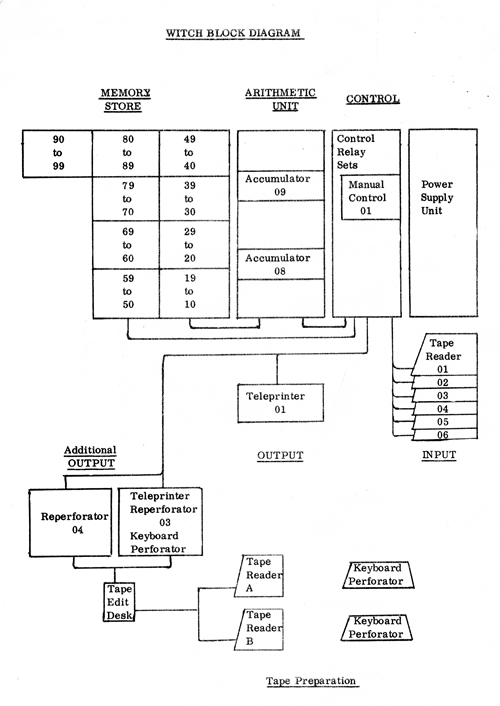
WITCH
THE WOLVERHAMPTON INSTRUMENT FOR TEACHING COMPUTATION FROM HARWELL
Ref. PH/MAP/8.10.59
HISTORICAL
This computer was first envisaged in 1947 and designed as a reliable machine to perform routine and repetitive calculations normally done by operators with desk machines. It was completed in 1950 and replaced by a more modern and faster machine in 1956. Forty colleges applied for the computer when it was offered as a gift and the then Wolverhampton and Staffordshire College of Technology was selected from a short list of nine. Since installation by college staff in 1957 it has been modified to give its maximum storage capacity of ninety-eight digit numbers, and plug boards added to give various print layouts.
DESIGN
827 "Dekatron" cold cathode tubes are used in arithmetic stores and circuits thus avoiding translation to the binary code. 141 other valves are used in the pulse generator, switching and stabiliser circuits.
The action and store selection is carried out by about 400 Post Office type relays. These are primarily responsible for the slow action, which is offset by reliability and economy in design.
Orders can be stored, but are normally obeyed as soon as read from an input tape.
FACILITIES
Input is by six tape readers addressed 01 to 06 which can carry orders or numbers on standard five-hole tape. The arithmetic orders of addition, subtraction, multiplication and division can be obeyed in any order on any two numbers in stores addressed 10 to 99 if not in the same group of ten. The accumulator is addressed 09 and being used for multiplication and division has fifteen digits.
The first Dekatron in any store is used to indicate the sign, the remaining eight indicating the number; the decimal point is always placed after the first digit.
Output can be either on a modified teleprinter or a re-perforator addressed 03 and 04 respectively.
By means of non arithmetic orders the sign of a store may be examined, the result of this examination may be used to transfer the control to any tape reader or store or to search for a "'block number" which may mark any particular sequence, on a tape reader.
ELECTRONIC ACTION
Pairs of up to ten pulses are required to step round the discharge glow on a Dekatron. The A pulses are supplied normally but the B pulses are switched. via transfer or carry units, there being one of each per digit and sign up to the maximum capacity of the accumulator. The decimal point is effectively shifted by a bank of relays which switch the input of the transfer units to the next digit.
The translator is based on a special Dekatron having all ten cathodes brought out. It accepts "earths" on two wires of a five wire input (representing the five holes on the tape) and converts them to pulses to add the required number to a store Dekatron. Alternatively it can accept a number from a transfer unit and convert it to a five wire output for the teleprinter or reperforator.
RELAY ACTION
Three relays control the reading in of five digit orders and set up the conditions for selecting the appropriate arithmetic function and the two associated stores. After these have been checked a further three relays control the action, these
set up the appropriate decimal shift, check the sign and start the pulse generator; this is repeated for as many digits as are required when used in multiplication and division. When the action is completed, the order sequence reads in the next order.
The order sequence relays also set up the required relay circuits for non-arithmetic functions. When obeyed, orders for sign examination and print layout are held until changed by a new order. The decimal shift order is cancelled after the next addition or subtraction.
An alarm is normally given to indicate a fault but this can be delayed so that three attempts at the program are made before it is abandoned.
CONCLUSION
WITCH has been in continuous use since assembly at Wolverhampton in September 1957, being the first computer to be installed in a Technical College.
As a teaching aid it is without equal as all numbers can be read directly through the perspex panels and the progress of any calculation studied at any stage. The action can be stopped at any time and numbers and orders inserted manually for instruction purposes.
Apart from use within the college it is being used by local industry and has proved invaluable in cases where calculation would be tedious.
It is probably the most reliable first generation computer still in use. Not being modern and sophisticated, the order code is simple and can be memorised in a few minutes.
Within its capacity Witch can do any problem suitable for a modern computer.
NOTE: Certain aspects of the design are described in articles published in 'Electronic Engineering' for August and September 1951.